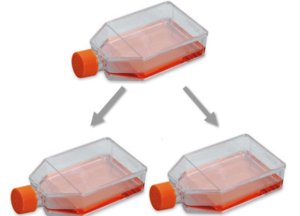HEK293 are rounded cells that grow in suspension in cell culture, although initially they were an adherent cell line. HEK-293 cells should be grown in a complete SFMII growth medium supplemented with 4 mM L-glutamine. Flasks should be incubated at 37°C in 5% CO2 and HEK293 cell doubling time is approximately 34 hours.

Subculture Protocol for HEK293
Renew medium 2-3 times a week, and keep cell count between 1 x 105 and 3 x 105 cells/mL. Do not allow cell concentration to exceed 1 x 106 cells/mL.
An easier method to subculture cells is by centrifuging and resuspending in fresh medium:
- Transfer cell suspension to centrifuge tube
- Rap side of emptied flask to remove any semi-adherent cells
- Resuspend newly dislodged cells in 5 mL medium and aspirate with a serological pipette to disperse clumps
- Transfer resuspended cells into centrifuge tube with main cell suspension
- Centrifuge at 125 x g for 5-7 minutes
- Aspirate supernatant and resuspend cells with fresh medium
HEK293 Cryopreservation
HEK 293 cells can be cryopreserved in conditioned growth medium supplemented with 10% (v/v) DMSO at 1 x 106cells/mL. Store frozen cell vials in the liquid nitrogen vapor phase.
HEK293 Cell Viability
Cell viability is the number living cells relative to the total number of cells. Trypan blue exclusion is the historical method commonly used to determine cell viability. Briefly, trypan blue is added to the cell suspension and observed on a hemocytometer. A non-viable cell has a weakened cell membrane and allows trypan blue to pass through the membrane. The total cell population and trypan blue stained cells are counted under a microscope. Healthy cells are considered to be a cell suspension with more than 85% viable cells as determined by the following equation:
% viable cells = [ 1 – (number of blue cells/number of total cells) ] * 100
Links
Outsource Western Blot CRO Services
Stable Cell Line Generation Services
List of Companies Offering Lab Services
HEK293 research articles
- Production of P-glycoprotein: HEK 293 cells were transfected to transiently express P-glycoprotein with a histidine tag to study the phenomenon of drug efflux. The P-glycoprotein was then purified with nickel-chelate chromatography and analyzed for drug binding and drug-stimulated ATPase activity. The results of this study suggested that drug-stimulated ATPase activity does not always match to the drug-resistant phenotype. [LINK]
- Expression of μ-opioid receptor (μR): In this study, HEK 293 cells were used to express the μR molecule with an amino-terminal epitope tag. The tagged receptor was demonstrated to be comparable to the untagged receptor in binding of target ligands and inhibition of cyclic AMP accumulation. The tagged receptor was used to investigate the intracellular trafficking of the μR, and found that movement of the μR is agonist-dependent. [LINK]
- Expression of G-protein coupled receptors (GPCRs): GPCRs are signaling proteins often produced in HEK 293 cells. In this study, microarrays were used to measure mRNA expression in a library of GPCR genes in several common GPCR-producing cell lines. The generation of this mRNA profile will aid future researchers in selection of the most appropriate cell line for their purposes, as well as elucidating interactions between GPCRs and related signaling molecules. [LINK]
HEK293 Cell │ HEK293 Cell Culture │ Transfection Information │ HEK293 Transfection Reagent